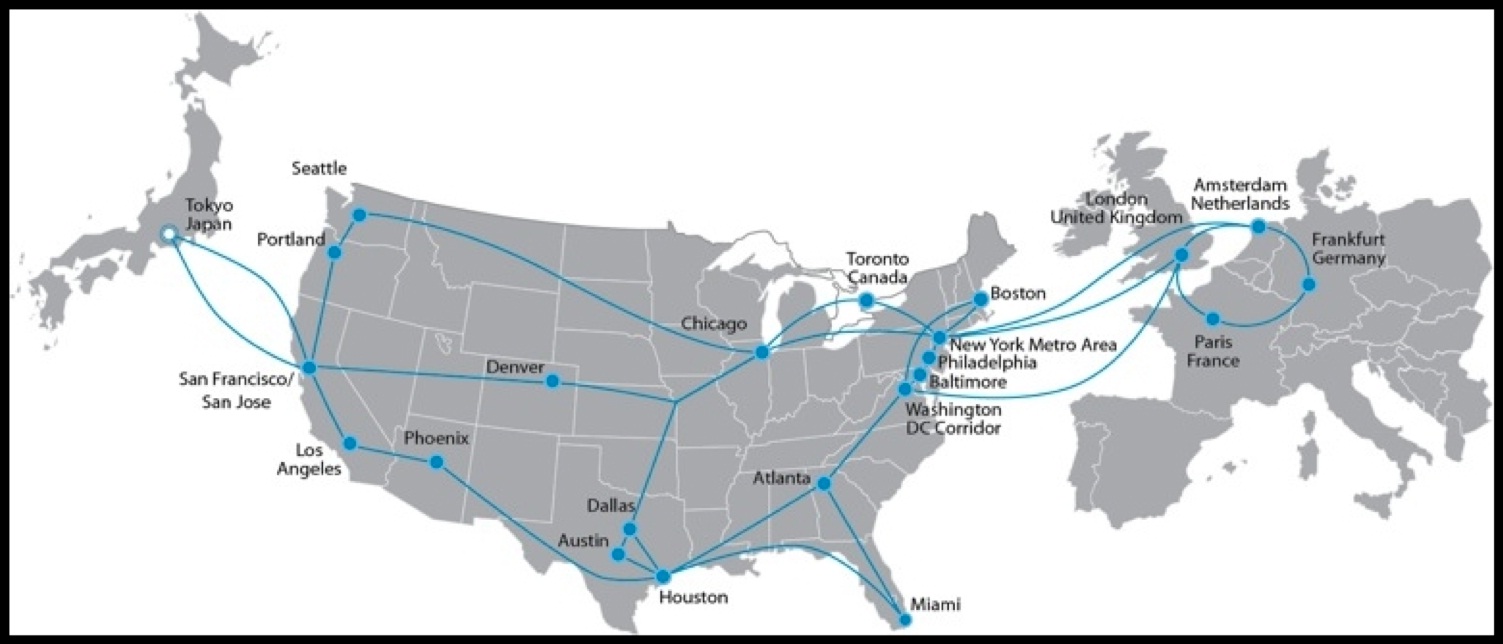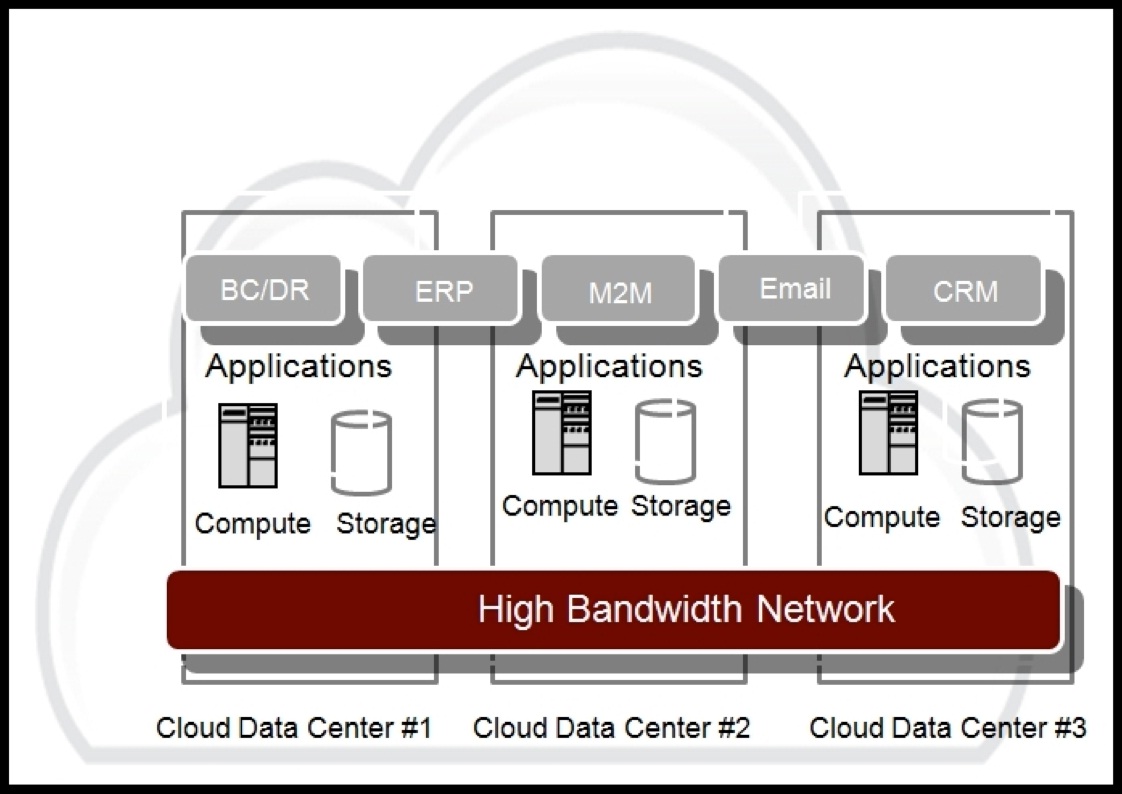Imagine a global fiber network that links over 450 data centers, offers bandwidth that scales from 100M to 100G, and has virtually no latency. It’s a game changer that’s lighting up the cloud environment.
The communications facility comes from AboveNet, a company that employs a private optical network to provide high-bandwidth connectivity services to businesses and carriers. The network currently links more than 500 data centers, and services are being delivered to around 3,200 commercial buildings in the U.S. and Europe.
Fiber delivers more bandwidth than most of us can imagine, but bandwidth isn’t the only factor; ultra-low latency, e.g. sub 5ms, is the critical parameter for real-time information exchange between sites, as required by applications such as video conferencing and telephony. The game that fiber changes is the need to have a backup facility in the immediate vicinity, i.e. it doesn’t matter how far away it is as long as the latency figure is ultra-low. Legacy networks are constrained because they employ indirect routes that traverse multiple exchanges, each of which adds latency.
The performance of AboveNet’s private network is not subject to the bursts of traffic demand that are made on a public network. Employing a private infrastructure also allows enterprises to employ a private cloud that is secure and which has high-bandwidth connectivity to each data center, thereby supporting both storage and processing virtualization. Virtualization allows applications to be economically deployed in multiple data centers, which means that private clouds are intrinsically robust.

Figure 1. The network that’s lighting up the cloud comes from AboveNet. It offers solutions that bypass the ILEC/CLEC networks and provide direct metro access to WDM, Ethernet, VPN and IP networks. Managed services address critical IT business issues such as regulatory compliance, business continuity, disaster recovery, and security.
LAN PERFORMANCE AND GIGABIT SERVICES
Moving applications into the cloud changes the architecture of an enterprise’s environment but it should not be allowed to change the performance. Service providers have to deliver LAN network-quality performance over a wide area network, and that can be tough. In addition to employing indirect routes, legacy networks are also constrained when the time comes to scale the service. Each legacy exchange has to be upgraded, and that takes time. Moreover, it represents a significant investment for the network provider, and that might mean that performance hits a wall. Enterprises are moving up to 10 Gbps and will want to go higher in future, and this creates a capacity crunch on legacy TDM networks. It can be realized but it is not economic: the cost is around twice that of an AboveNet Ethernet circuit. Moreover, a company can move up from 45 Mbps TDM to 100 Mbps Ethernet for a minimal monthly charge increase.
Fiber networks are not so constrained. They deliver performance that scales from 100 Mbps to 100 Gbps, and scaling up only requires a change of plug-in card on the enterprise’s Ethernet switch. These high-performance figures are realized because there is a dedicated channel between the two end-points. You can have more than one channel running in a single optic fiber, but they must be independent. This can be achieved by using different wavelengths for each channel.
PIGGYBACK SERVICES
Since 2003, AboveNet has focused on demanding markets, such as finance, healthcare, and government, and the provider’s network reaches important business and financial centers. In North America these include New York, Boston, Chicago, Philadelphia, Washington, Atlanta, San Francisco, Seattle, Phoenix, Los Angeles, Houston, Dallas and Toronto. In Europe, it embraces London, Paris, Amsterdam and Frankfurt. All the stock exchanges in those financial centers employ the network, as do many of the attendant financial institutions.
The company has built a solid customer base in markets such as finance, government and healthcare. All the stock exchanges in those financial centers employ AboveNet’s managed services, as do major media companies needing to circulate massive video files for processing between international sites. The company is currently targeting the enterprise market and is offering connectivity services that piggyback on the established network. In other words, if your business lies within reach of this fiber footprint, then, as illustrated, you can access business-class cloud services across a WAN that delivers LAN-like performance.

Figure 2. The ideal cloud model is to have all major computing and data storage resources being safely sited in a few secure and well maintained, energy-efficient datacenters. High bandwidth connectivity at each data center is required in order to support storage and virtualization.
AboveNet is obviously not the only service provider that offers light-speed connectivity, but it is distinguished by the fact that the company does not build data centers or handle low-bandwidth bursts of traffic like voice or other types of digital telecommunications signals. The decision to focus on high bandwidth connectivity and a single communications technology, Carrier Ethernet, allowed AboveNet to build this high-performance, low-latency, global network.
CLOUD STRATEGIES
Enterprises can elect to go for a public, private or hybrid solution, but hybrid is emerging as the preferred option. IT management does have valid concerns about the security and availability of public cloud offers so it makes sense to consolidate the critical applications in-house by building a private cloud. Less demanding applications can then be provided by a robust public cloud offer. For example, should precious, limited internal resources be used to manage and maintain the company’s email service? However, the quality and performance of this kind of hybrid mix-and-match of private and public computing is contingent on the performance of the connecting WAN.
AboveNet emphasizes the fact that their private, very wide area network can be used to connect public as well as private clouds and this enables a simpler, more business focused network topology. High bandwidth connectivity also allows workloads to migrate from private to public clouds.
In addition to providing connectivity between major conurbations, fiber is also for the “last mile”, i.e. to reach into the data centers of enterprises. Multinationals can therefore interconnect their data centers in London, Frankfurt, New York, etc, and all traffic stays not only “on-net” but also on a network that is managed by one supplier.
CONSOLIDATED FACILITIES
Virtualization enables computing resources to be used more efficiently. It removes the earlier need to have spare capacity in order to accommodate peak workloads, but primary data centers still required a backup facility in the event of a malfunction. Therefore a valuable resource would be idle for most of the time.
However, in the cloud model there are no primary data centers. There are multiple ways of accessing the applications. Workloads are distributed around the network and when you have high-speed connectivity between data centers they function as a huge, consolidated resource. Therefore the regular perception of a backup is no longer valid although the intrinsic functionality is there. Backups, like workloads, are distributed around the network.
CONCLUSIONS
For a viable private cloud you need secure, reliable and high bandwidth connectivity for each datacenter to support both storage and processing virtualization. For enterprise access to the public cloud you also need security and reliability, but speed and classes of service are less stringent. End-to-end fiber is a game-changing development. It changes mindsets as well as performance.

Want to learn more about cloud communications? Then be sure to attend the Cloud Communications Expo, collocated with ITEXPO West 2012 taking place Oct 2-5, in Austin, TX. The Cloud Communications Expo will address the growing need of businesses to integrate and leverage cloud based communications applications, process enhancement techniques, and network based communications interfaces and architectures. For more information on registering for the Cloud Communications Expo click here.
Stay in touch with everything happening at Cloud Communications Expo. Follow us on Twitter.
Edited by Brooke Neuman
 Internet Telephony Magazine
Click here to read latest issue
Internet Telephony Magazine
Click here to read latest issue CUSTOMER
CUSTOMER  Cloud Computing Magazine
Click here to read latest issue
Cloud Computing Magazine
Click here to read latest issue IoT EVOLUTION MAGAZINE
IoT EVOLUTION MAGAZINE




